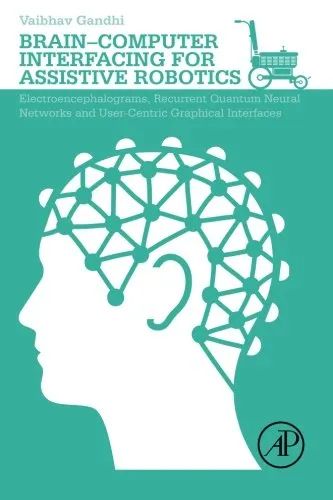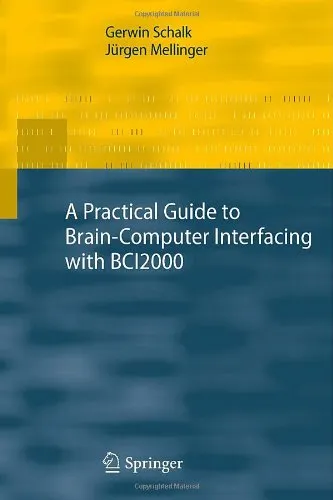Brain-Computer Interfacing for Assistive Robotics: Electroencephalograms, Recurrent Quantum Neural Networks, and User-Centric Graphical Interfaces
4.5
Reviews from our users

You Can Ask your questions from this book's AI after Login
Each download or ask from book AI costs 2 points. To earn more free points, please visit the Points Guide Page and complete some valuable actions.کتاب های مرتبط:
Introduction
Welcome to the fascinating world of brain-computer interfacing and assistive robotics, where neuroscience converges with cutting-edge technology to revolutionize how humans interact with machines. This book, "Brain-Computer Interfacing for Assistive Robotics: Electroencephalograms, Recurrent Quantum Neural Networks, and User-Centric Graphical Interfaces," seeks to demystify the complex interplay between human cognition and robotics. Targeted at both industry professionals and academia, it provides an in-depth exploration of this interdisciplinary field through technical insights, practical applications, and prospective advancements.
Detailed Summary of the Book
The book is organized into five comprehensive sections, each dedicated to fundamental aspects of brain-computer interfacing (BCI) and assistive robotics.
The first section introduces the foundational concepts of Electroencephalograms (EEGs), offering readers a deep dive into how brain signals are captured and interpreted. We discuss the principles behind signal processing and feature extraction, providing a framework for understanding how cognitive patterns translate into digital data.
The second section delves into Recurrent Quantum Neural Networks (RQNNs), emerging as powerful tools in the realm of complex data analysis. Here, we detail the architecture of these quantum-inspired networks and their superior capability in handling temporal sequences, making them ideal for processing EEG data. This section provides thorough examples and case studies demonstrating their application in assistive robotics.
The third section explores User-Centric Graphical Interfaces. Emphasizing design principles, the discussion centers around creating intuitive, responsive, and accessible interfaces that maximize user engagement. Methods for evaluating user experience and enhancing interface design based on neurofeedback are presented to ensure technology remains user-focused.
Integrated applications in assistive robotics are discussed in the fourth section, examining scenarios where BCIs can significantly impact users with physical or cognitive impairments. Practical case studies illustrate how brain-computer interfacing has been successfully applied to control prosthetic limbs, wheelchairs, and communication devices, significantly improving the quality of life for individuals with disabilities.
Finally, the book addresses the ethical considerations and future trends in the field of BCI for assistive robotics. We explore the societal implications of these technologies and foresee future challenges and opportunities.
Key Takeaways
- Comprehensive understanding of EEGs and their role in brain-computer interfacing.
- Insight into the architecture and applications of Recurrent Quantum Neural Networks.
- Best practices in designing user-centric graphical interfaces for assistive technology.
- Case studies showcasing real-world applications and impact on assistive robotics.
- Ethical discussions and future prospects of BCI technologies in society.
Famous Quotes from the Book
"The nexus of brain and computer is not just circuitry; it is a symphony where human thoughts compose the melody and technology orchestrates the harmony."
"In the realm of assistive robotics, understanding the mind is as crucial as innovating the machine."
Why This Book Matters
The significance of this book lies in its ability to explain complex subjects in an accessible manner while pushing the boundaries of technological advancements and human-computer interaction. It serves as a vital resource for researchers, professionals, and students eager to explore the integration of human neurophysiology with robotics. By examining current technologies and insights into future developments, this book is a beacon for those looking to contribute to impactful, life-enhancing innovations in assistive devices.
As the demand for intelligent assistive solutions grows, understanding the science and application of brain-computer interfacing will be crucial. This work not only lays the groundwork for current technologies but also inspires a new generation of thinkers who will carry forward the legacy of this interdisciplinary endeavor.
Free Direct Download
You Can Download this book after Login
Accessing books through legal platforms and public libraries not only supports the rights of authors and publishers but also contributes to the sustainability of reading culture. Before downloading, please take a moment to consider these options.
Find this book on other platforms:
WorldCat helps you find books in libraries worldwide.
See ratings, reviews, and discussions on Goodreads.
Find and buy rare or used books on AbeBooks.
1321
بازدید4.5
امتیاز50
نظر98%
رضایتReviews:
4.5
Based on 0 users review
"کیفیت چاپ عالی بود، خیلی راضیام"
Questions & Answers
Ask questions about this book or help others by answering
No questions yet. Be the first to ask!



